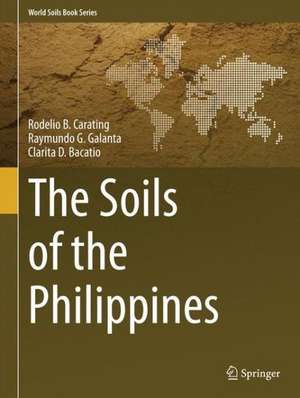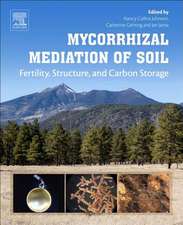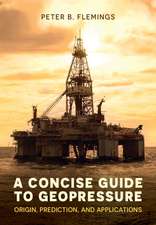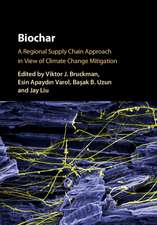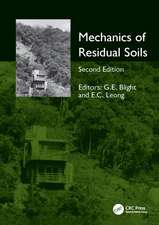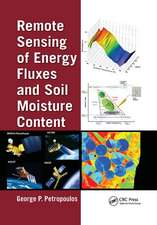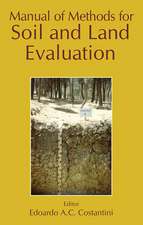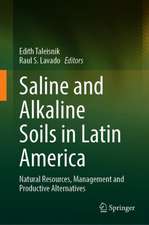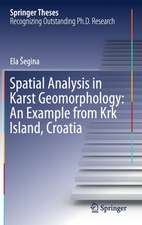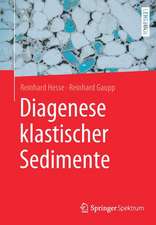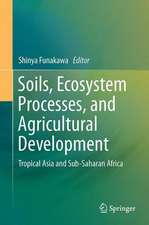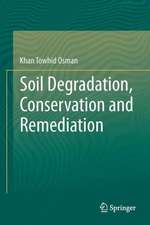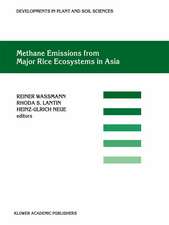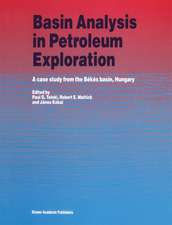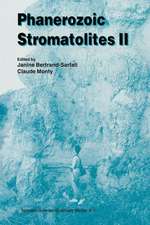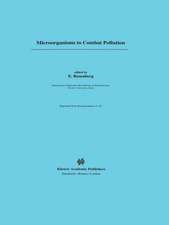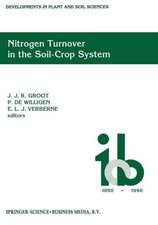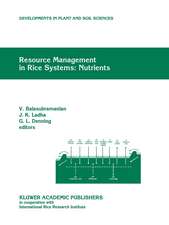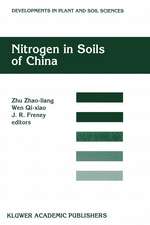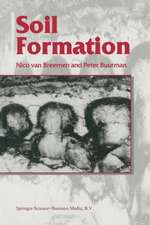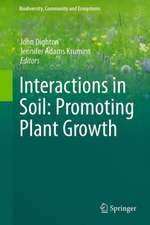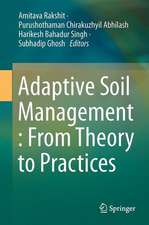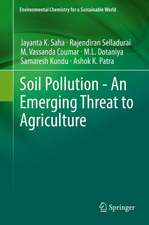The Soils of the Philippines: World Soils Book Series
Autor Rodelio B. Carating, Raymundo G. Galanta, Clarita D. Bacatioen Limba Engleză Hardback – 25 iun 2014
This book brings together discussions on soils and soil mapping units and up-to-date international techniques and technologies. It makes soils relevant to current political realities and national issues. As soil survey moves from a reductionist agricultural-development planning tool to a more holistic and integrated approach, to enable us to understand our dynamic and complex environment, The Soils of the Philippines will be the only source of authoritative and updated data on soil resources for macro-level resource management planning for decades to come.
With a vanishing breed of experienced soil surveyors, not only in the Philippines but also worldwide, it may remain the only book on Philippine soils for the next hundred years or more. Since soils follow a geological and not a human time frame, the contents of this volume will stay relevant for soil surveyors even in a fast changing world.
As the country leaps from an agricultural economy towards modernization and a more diversified economic base, some of the soil series in the Philippines, for example the Guadalupe series underlying the skyscrapers of Makati City, are becoming extinct as a result of urban development. Therefore, thisbook serves as the repository for the soils that we possess, the soils that have been lost through decades of urbanization while, at the same time, it creates a soil classification system for the soils we are yet to discover.
Toate formatele și edițiile
| Toate formatele și edițiile | Preț | Express |
|---|---|---|
| Paperback (1) | 958.88 lei 6-8 săpt. | |
| SPRINGER NETHERLANDS – 27 sep 2016 | 958.88 lei 6-8 săpt. | |
| Hardback (1) | 978.12 lei 3-5 săpt. | |
| SPRINGER NETHERLANDS – 25 iun 2014 | 978.12 lei 3-5 săpt. |
Din seria World Soils Book Series
- 18%
 Preț: 962.81 lei
Preț: 962.81 lei - 18%
 Preț: 1231.01 lei
Preț: 1231.01 lei - 18%
 Preț: 974.98 lei
Preț: 974.98 lei - 18%
 Preț: 791.71 lei
Preț: 791.71 lei - 18%
 Preț: 914.20 lei
Preț: 914.20 lei - 18%
 Preț: 998.97 lei
Preț: 998.97 lei - 15%
 Preț: 649.87 lei
Preț: 649.87 lei - 15%
 Preț: 646.62 lei
Preț: 646.62 lei - 18%
 Preț: 739.62 lei
Preț: 739.62 lei - 15%
 Preț: 649.87 lei
Preț: 649.87 lei - 18%
 Preț: 949.23 lei
Preț: 949.23 lei - 15%
 Preț: 642.65 lei
Preț: 642.65 lei - 20%
 Preț: 607.18 lei
Preț: 607.18 lei - 24%
 Preț: 762.76 lei
Preț: 762.76 lei - 24%
 Preț: 1076.12 lei
Preț: 1076.12 lei - 24%
 Preț: 771.00 lei
Preț: 771.00 lei - 20%
 Preț: 579.72 lei
Preț: 579.72 lei - 20%
 Preț: 574.08 lei
Preț: 574.08 lei - 24%
 Preț: 921.11 lei
Preț: 921.11 lei - 20%
 Preț: 608.98 lei
Preț: 608.98 lei - 24%
 Preț: 750.99 lei
Preț: 750.99 lei - 24%
 Preț: 861.53 lei
Preț: 861.53 lei - 24%
 Preț: 966.55 lei
Preț: 966.55 lei - 24%
 Preț: 816.93 lei
Preț: 816.93 lei - 20%
 Preț: 579.72 lei
Preț: 579.72 lei - 24%
 Preț: 602.43 lei
Preț: 602.43 lei - 20%
 Preț: 591.80 lei
Preț: 591.80 lei - 24%
 Preț: 747.88 lei
Preț: 747.88 lei - 18%
 Preț: 907.11 lei
Preț: 907.11 lei - 20%
 Preț: 589.56 lei
Preț: 589.56 lei - 24%
 Preț: 640.76 lei
Preț: 640.76 lei - 24%
 Preț: 813.39 lei
Preț: 813.39 lei - 24%
 Preț: 886.54 lei
Preț: 886.54 lei
Preț: 978.12 lei
Preț vechi: 1192.82 lei
-18% Nou
Puncte Express: 1467
Preț estimativ în valută:
187.16€ • 195.41$ • 154.90£
187.16€ • 195.41$ • 154.90£
Carte disponibilă
Livrare economică 14-28 martie
Preluare comenzi: 021 569.72.76
Specificații
ISBN-13: 9789401786812
ISBN-10: 940178681X
Pagini: 368
Ilustrații: XXII, 346 p. 226 illus., 219 illus. in color.
Dimensiuni: 210 x 279 x 25 mm
Greutate: 1.38 kg
Ediția:2014
Editura: SPRINGER NETHERLANDS
Colecția Springer
Seria World Soils Book Series
Locul publicării:Dordrecht, Netherlands
ISBN-10: 940178681X
Pagini: 368
Ilustrații: XXII, 346 p. 226 illus., 219 illus. in color.
Dimensiuni: 210 x 279 x 25 mm
Greutate: 1.38 kg
Ediția:2014
Editura: SPRINGER NETHERLANDS
Colecția Springer
Seria World Soils Book Series
Locul publicării:Dordrecht, Netherlands
Public țintă
ResearchCuprins
Introduction.- The Soils of the Lowlands.- The Soils of the Uplands.- The Soils of the Hills and Mountains.- Soils and the Philippine Economy.- Soil Issues and Challenges.
Notă biografică
The first soil survey in the Philippines was done by Mr. Clarence Dorsey, an American soil scientist in the province of Batangas in 1903. The Soils of the Philippines, however, is the first comprehensive summary of more than a century of soil-survey work in this country. It integrates the soil concepts of the reconnaissance soil-survey results, which commenced as early as 1934 and continued until the mid 1960s, with the semi-detailed soil surveys that continue to this day. The result is the first-ever genetic key for classifying Philippine soils at soil series level; thus, making it possible for any newcomers to the soil survey field to confidently produce their own soil map, at a more detailed map scale, to suit the project requirements.
This book brings together discussions on soils and soil mapping units and up-to-date international techniques and technologies. It makes soils relevant to current political realities and national issues. As soil survey moves from a reductionist agricultural-development planning tool to a more holistic and integrated approach, to enable us to understand our dynamic and complex environment, The Soils of the Philippines will be the only source of authoritative and updated data on soil resources for macro-level resource management planning for decades to come.
With a vanishing breed of experienced soil surveyors, not only in the Philippines but also worldwide, it may remain the only book on Philippine soils for the next hundred years or more. Since soils follow a geological and not a human time frame, the contents of this volume will stay relevant for soil surveyors even in a fast changing world.
As the country leaps from an agricultural economy towards modernization and a more diversified economic base, some of the soil series in the Philippines, for example the Guadalupe series underlying the skyscrapers of Makati City, are becoming extinct as a result of urban development.Therefore, this book serves as the repository for the soils that we possess, the soils that have been lost through decades of urbanization while, at the same time, it creates a soil classification system for the soils we are yet to discover.
This book brings together discussions on soils and soil mapping units and up-to-date international techniques and technologies. It makes soils relevant to current political realities and national issues. As soil survey moves from a reductionist agricultural-development planning tool to a more holistic and integrated approach, to enable us to understand our dynamic and complex environment, The Soils of the Philippines will be the only source of authoritative and updated data on soil resources for macro-level resource management planning for decades to come.
With a vanishing breed of experienced soil surveyors, not only in the Philippines but also worldwide, it may remain the only book on Philippine soils for the next hundred years or more. Since soils follow a geological and not a human time frame, the contents of this volume will stay relevant for soil surveyors even in a fast changing world.
As the country leaps from an agricultural economy towards modernization and a more diversified economic base, some of the soil series in the Philippines, for example the Guadalupe series underlying the skyscrapers of Makati City, are becoming extinct as a result of urban development.Therefore, this book serves as the repository for the soils that we possess, the soils that have been lost through decades of urbanization while, at the same time, it creates a soil classification system for the soils we are yet to discover.
Textul de pe ultima copertă
The first soil survey in the Philippines was done by Mr. Clarence Dorsey, an American soil scientist in the province of Batangas in 1903. The Soils of the Philippines, however, is the first comprehensive summary of more than a century of soil-survey work in this country. It integrates the soil concepts of the reconnaissance soil-survey results, which commenced as early as 1934 and continued until the mid 1960s, with the semi-detailed soil surveys that continue to this day. The result is the first-ever genetic key for classifying Philippine soils at soil series level; thus, making it possible for any newcomers to the soil survey field to confidently produce their own soil map, at a more detailed map scale, to suit the project requirements.
This book brings together discussions on soils and soil mapping units and up-to-date international techniques and technologies. It makes soils relevant to current political realities and national issues. As soil survey moves from a reductionist agricultural-development planning tool to a more holistic and integrated approach, to enable us to understand our dynamic and complex environment, The Soils of the Philippines will be the only source of authoritative and updated data on soil resources for macro-level resource management planning for decades to come.
With a vanishing breed of experienced soil surveyors, not only in the Philippines but also worldwide, it may remain the only book on Philippine soils for the next hundred years or more. Since soils follow a geological and not a human time frame, the contents of this volume will stay relevant for soil surveyors even in a fast changing world.
As the country leaps from an agricultural economy towards modernization and a more diversified economic base, some of the soil series in the Philippines, for example the Guadalupe series underlying the skyscrapers of Makati City, are becoming extinct as a result of urban development.Therefore, this book serves as the repository for the soils that we possess, the soils that have been lost through decades of urbanization while, at the same time, it creates a soil classification system for the soils we are yet to discover.
This book brings together discussions on soils and soil mapping units and up-to-date international techniques and technologies. It makes soils relevant to current political realities and national issues. As soil survey moves from a reductionist agricultural-development planning tool to a more holistic and integrated approach, to enable us to understand our dynamic and complex environment, The Soils of the Philippines will be the only source of authoritative and updated data on soil resources for macro-level resource management planning for decades to come.
With a vanishing breed of experienced soil surveyors, not only in the Philippines but also worldwide, it may remain the only book on Philippine soils for the next hundred years or more. Since soils follow a geological and not a human time frame, the contents of this volume will stay relevant for soil surveyors even in a fast changing world.
As the country leaps from an agricultural economy towards modernization and a more diversified economic base, some of the soil series in the Philippines, for example the Guadalupe series underlying the skyscrapers of Makati City, are becoming extinct as a result of urban development.Therefore, this book serves as the repository for the soils that we possess, the soils that have been lost through decades of urbanization while, at the same time, it creates a soil classification system for the soils we are yet to discover.
Caracteristici
The book shows soil thematic layers which are overlain on satellite images as base map The book contains an updated soil map to consolidate several decades of soil survey activities The book contains a first ever master listing of all soil series in the Philippines Includes supplementary material: sn.pub/extras
